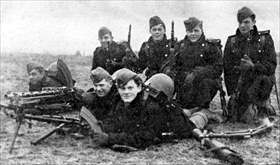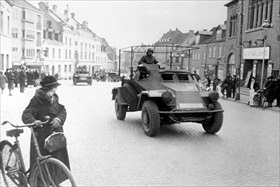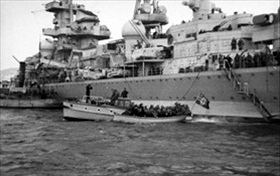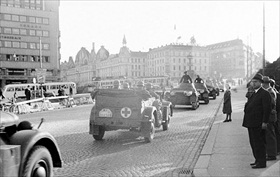HITLER ORDERS CONQUEST OF DENMARK, NORWAY
Berlin, Germany · April 9, 1940
On this date in 1940 German land, sea, air, and specialized forces advanced overland into Denmark and attacked various points along Norway’s coast from the air and sea. Both Scandinavian countries had deficiencies in men, organization, training, and modern equipment that prevented a credible defense. Tiny Denmark, with 3.8 million people, fell within hours. A circular in the capital, Copenhagen, that day announced that the country was now under German “protection” against “British attack.” The German ambassador to Denmark swore a solemn oath that Germany did not wish to interfere in Denmark’s internal affairs and would respect her integrity and independence after the war. Luckily, two-thirds of the Danish naval force (240 ships and 6,500 men) were outside territorial waters on the day of the invasion, allowing the majority of Danish ships to escape to Allied harbors and begin sailing under Allied flags.
As for Norway, with a population of 3 million, that country took no precautions to meet a potential German threat, being fixated instead on a series of British violations of its territorial waters in March and early April. The Western Allies (British, French, Polish, and Norwegian), despite plenty of warnings of troop buildup and embarkations along Germany’s North Sea and Baltic coasts, followed by sightings of sizable German naval units steaming north at high speed, could have prevented the loss of Norway to the Nazi blitzkrieg had they fully or partially mobilized between April 5 and 9, mined harbors, fully manned coastal defenses, provided adequate infantry protection for Norwegian airfields, and abandoned the notion that the Kriegsmarine was cowed by the Royal Navy. Instead, the Norwegian government appeared paralyzed, its 13,000-strong army and 5,200 naval personnel unable to mount a truly effective defense against less than 20,000 of the enemy.
Against a backdrop of the Allies’ ill-prepared, poorly equipped, and badly led reactive land force, Norway bravely resisted Nazi aggression for roughly two months, though the outcome was never in doubt after Germany established air bases in the country that more than compensated for the vastly superior British Navy offshore. Norway’s 126 years of continuous peace ended, replaced by five years of enemy occupation with the help of 40,000 Norwegian collaborators, or “Quislings.”
[amazon_carousel widget_type=”ASINList” width=”600″ height=”200″ title=”Recommended Reading” market_place=”US” shuffle_products=”False” show_border=”False” asin=”1846031176,1935149334,9652293970,1628723718,1555716385,0803277873,1591143233,1848326610,1591143314,160888029X” /]
Operation Weseruebung, Germany’s Conquest of Denmark and Norway, April 1940
 |  |
Left: Danish troops on the morning of the German invasion, codenamed Operation Weseruebung, April 9, 1940. Hours later two of the squad’s seven men had fallen to German bullets. They were two out of 16 Danish soldiers who died in the invasion. German troop losses were minimal in Denmark (203 killed or wounded) and Norway (5,296 killed or wounded). Not so for the Kriegsmarine. The Royal Navy succeeded in crippling the German Navy as a fighting force. (Nearly half of German losses in Norway were at sea.) From May 1940 onwards, the Kriegsmarine was reduced to a fleet of submarines and a handful of heavy warships that were used as commerce raiders.
![]()
Right: German radio armored car moving north through Viborg, central Jutland (Denmark), April 12, 1940.
 |  |
Left: German heavy cruiser Admiral Hipper landing troops in Norway, 1940. The assault on Denmark and Norway represented the first joint land-air-and-sea campaign in the history of warfare. It turned out to be the Wehrmacht’s only campaign that was planned, launched, and completed by the three services.
![]()
Right: German troops in Oslo, May 1940. In the background is the Victoria Terrasse, which later became Gestapo headquarters. The complex held the interrogation center for all prisoners in Oslo, and the place became synonymous with torture and abuse.
Newsreel of the German Occupation of Denmark (English subtitles)
![]()

 History buffs, there is good news! The Daily Chronicles of World War II is now available as an ebook for $4.99 on Amazon.com. Containing a year’s worth of dated entries from this website, the ebook brings the story of this tumultuous era to life in a compelling, authoritative, and succinct manner. Featuring inventive navigation aids, the ebook enables readers to instantly move forward or backward by month and date to different dated entries. Simple and elegant! Click
History buffs, there is good news! The Daily Chronicles of World War II is now available as an ebook for $4.99 on Amazon.com. Containing a year’s worth of dated entries from this website, the ebook brings the story of this tumultuous era to life in a compelling, authoritative, and succinct manner. Featuring inventive navigation aids, the ebook enables readers to instantly move forward or backward by month and date to different dated entries. Simple and elegant! Click 











